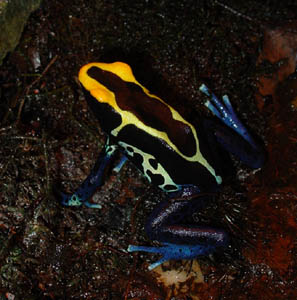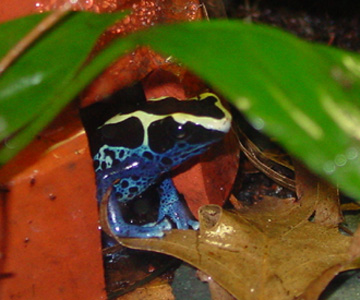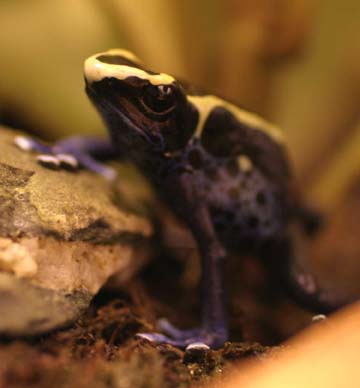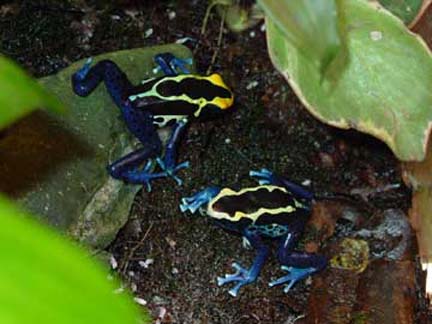
 |
|
Dendrobates tinctorius is a great beginner frog. In the wild this frog inhabits areas of Surinam. Tincs come in a wide variety of sizes and color morphs and many of these morphs are available to the hobbyist. Never house different morphs of this frog together, this frog can and will interbreed and that is detrimental to the hobby. We have raised both the cobolt and the dwarf French Guianan morphs, but there are several other morphs on our wish list and we are always looking to trade for new morphs.
Dendrobates tinctorius is very common in captivity and one of the most popular species for hobbyists. In our experience these frogs climb and will take advantage of vertical space. They are bold but still like a heavily planted enclosure to make them feel secure. They are often a large frog and spend a lot of time in the lower sections of the enclosure in the moss and leaf litter, but as noted earlier there is a dwarf morph that is about 50% smaller than the other morphs. They are aggressive feeders and accept a wide variety of appropriately sized food. The sexual dimorphism in d. tinctorius is the same as Dendrobates Azureus, the males have much larger front toe pads than females. The females are also often larger than the males. The males can start calling at about 10 - 12 months but the call is very soft and hard to hear, it is usually easier to see the males calling than hear them. Toe pad size is the surest way to know that you have a male.
The picture at the bottom illustrates the size difference in the toe pads. The male is on the right and you can see that the toe pads are twice the size of the female�s. The size difference is not alway this dramatic, but the males are always larger. These frogs are best kept in pairs or in 2:1 (2 males to 1 female) ratios. Adult females can be very aggressive toward each other and although it is rare for frogs to kill each other, the stress caused by constant bullying can be fatal. A large, heavily planted enclosure will allow subordinate animals to escape the bullying and permit keeping these frogs in groups. The females initiate breeding in the species. She approaches and gently strokes the male, he responds by calling the female to him and leading her to an egg laying site. Mating usually takes place in some type of bower.
|
| Dendrobates tinctorius lay clutches of 4 to 8 eggs but a healthy pair can lay eggs every one or two weeks. The eggs are usually laid in a coco hut or similar bower. We leave the eggs in the enclosure for at least 24 hours after finding them to make sure that they are fertilized. Fertilized eggs are often "spread out" on the petri dish that is inside the bower. We raise our tadpoles individually in glass mason jars or in nested rubbermaid containers that have dividers and a screen bottom on the inside container. This setup is filtered with a small sponge type air filter. Filtration reduces the number of water changes needed. In this type of setup we keep pathos and aquatic plants in the rearing enclosure. Tads are fed a mixture of spirulina, chlorella, stinging nettle and bee pollen (2:2:1:1), we also feed "Aquarian" fish food about once a week. After the rear legs develop we expose the tads to UVB lighting daily. The tads morph out large and are fed d. melanogaster that are dusted daily with Repcal. We also dust weekly with Herptivite. We follow this dusting regime with our adult frogs too. The frogs reach maturity in 12-15 months. |
 |
 |
Summation:
Size- 35 - 60 mm, visual differences between sexes are apparent, females are slightly larger and rounder, males have a much larger toe pads on the front feet
Care- Tincs are easy to care for and a bold species.
Food- all types of fruit flies, small crickets, waxworms, confused flowerbeetle larvae, termites, field sweeping,
Eggs and Tads- clutches of 6 to 10 eggs, tads are omnivorous and should be raised singly
Temperature- 70°-80°
Locality - Surinam
|
|
|

